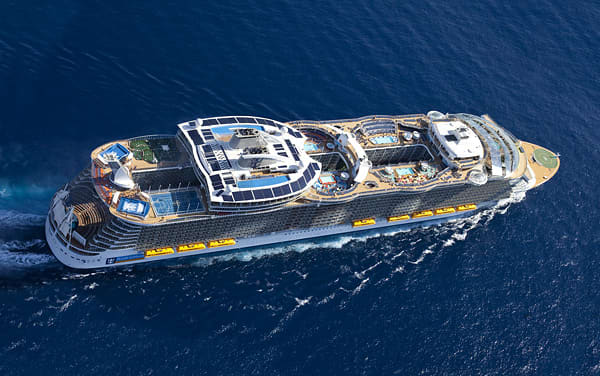
You may have heard about the negative effects that cruise ships can have on the environment and wondered how you could help. Here are some facts about cruise ship pollution that might surprise you. Learn more about the impacts on the environment, marine life and local economies as well as the pollution sources. We hope that you'll be more informed about the consequences of cruise ship pollution. But what's the real cost? You can't ignore it, but it's important to be aware of the facts.
Marine life
A cruise ship can produce large amounts of waste that enters the ocean, negatively affecting marine life. These solid wastes end up often in the stomachs and bellies of marine life and whales. These foreign items can choke or kill their digestive systems. Noise pollution also interferes with whale behavior, while water pollution can cause the ocean to lose oxygen. This can have devastating consequences for marine life. There are several ways to reduce pollution caused by cruise ships.

Coral reefs damaged
Cruise industry tends to ignore the problems of coral reefs as well as their inhabitants. Cruise ships require ports and other construction projects, and many hectares are destroyed. Dredging, or sifting through silt, is necessary for the ships to dock safely and deeper. Dredging can also damage a section of the reef because the water is not clear enough to support corals.
Local economies: Impact
A significant source of pollution are the maritime emissions from cruise ship ships. Recent studies have shown that a single ship can emit as many particulate matter and pollutants as 700 trucks. Due to shipping's emissions, between 40,000 and 100,000 people in Britain die each year. Even though cruise ships only make up a small portion of the world's shipping fleet, they can have a major impact on local economies along the coast. Shipboard incinerators can also contribute to the pollution problem, as they burn enormous amounts of waste and create ash.
Polluting factors
Marine Pollution Bulletin published a paper recently that revealed the extent to which the cruise industry has had an impact on the environment. It was revealed that a cruise vessel carrying more than two thousand seventy hundred passengers annually generates more rubbish than one tonne. Most of this waste is illegally disposed and incinerated at the sea. In addition to causing damage to the environment, the cruise industry can cause health problems for passengers and the local communities surrounding ports.

EPA report on cruise ship pollution
On January 31, 2008, the EPA published a full response to the public docket for the Cruise Ship Discharge Assessment Report. This document outlines the draft report's assessment of five major waste streams from cruise ships: sewage, graywater, oily bilge water, and hazardous waste. According to the draft report, cruise ships produce more than 3,000 tons of waste each week. This may seem like a lot, but the waste they produce is significant.
FAQ
Is food available on a cruise or not?
The answer to that question is yes All cruises include complimentary food. For the best experience, you'll need to purchase beverages
The cost varies depending on what type of ship you are sailing on. You might expect to pay between $20 and $30 per person for each beverage purchased while cruising on a luxury liner. For a smaller vessel, the cost of a drink will be around $10-15 per person.
Are you required to have a passport to travel on a cruise ship?
A passport is essential for anyone who wants to travel around the globe. You can travel to any country with a passport without needing a visa or other paperwork.
You might not be allowed into certain countries if you don't have a passport. You can also stay longer abroad with a passport.
Where should I go on my cruise?
You need to decide where you want go, if your goal is to visit different ports. This information can also be used as a way to narrow down your search. For example, if history is your passion, you may choose to cruise to destinations such as Alaska, Bermuda or Canada. If you are more into beaches and water sports, you might want an itinerary that includes destinations such as Jamaica, Aruba, Bahamas, Costa Rica, Panama, Hawaii, Tahiti, etc.
How much do I tip my Cruise Director
This is dependent on the cruise line. Some cruise directors get tips, while others do not. Asking your Cruise Director when you board a ship is the best way to determine if they are entitled to tips. They will often tell you if tips are expected.
Do I need to dress up when going on a cruise ship?
No, you don’t have to be dressed in formal wear or fancy attire. Relax and be comfortable.
Statistics
- The line estimates savings of 50% when you purchase this bundle. (travel.usnews.com)
- For an example of savings, Royal Caribbean offers up to a 40% discount with a dining package. (travel.usnews.com)
- If you're traveling alone, you may also need to factor in a single supplement, adding up to as much as 100% of the cruise fare. (travel.usnews.com)
- You'll need to budget around $80 per person per day for this option – and an additional 18% gratuity. (travel.usnews.com)
External Links
How To
How do I plan my first Cruise?
Like any other trip, planning a cruise requires you to think about many factors, including where to go, what activities, how much to budget, and what to do with your money. When planning your first cruise, you should know some things to keep in mind if cruising is new to you. Cruises usually last for three weeks longer than land vacations, so make sure you leave nothing out. These tips can make your vacation easier.
-
Book your cruise early. You should book at least 6 months in advance. This will allow you to get amazing deals and avoid the crowds. This will allow you to take your time researching the ship, destination, ports, activities, and more. There might be a great deal on airfare!
-
Choose a destination. - It doesn’t matter what port you choose. Just pick the one that interests you. There are lots of reasons why people love cruising to different destinations. Some love to travel while others prefer to relax and unwind on the boat. Whatever floats your boat, just remember to keep in mind the type of destination you'd like to visit. The Caribbean is the most popular destination, followed closely by Europe or Alaska.
-
Consider booking a suite - If money isn't an issue, book a suite. Suites include extra space, a private terrace, and additional amenities. These suites can usually be booked for $100-$300 per person, depending on their size and availability during your sailing date.
-
Make sure to check the weather forecast. Cruising often is associated with tropical climates. Don't forget about checking the weather forecasts when you visit ports. It's unpredictable in the ocean, especially in Antarctica or Alaska, so it is important to be aware of what the weather might be like before you book your cruise.
-
Keep it light when packing for a cruise. You should only bring 10 items. It's not necessary to pack too many clothes or shoes into your suitcase. Make sure to only bring what you really need. Consider layering clothing since you won't always have access to laundries onboard.
-
Do your research - Read online reviews before buying tickets. Be sure to review their policies regarding pricing, the services they provide, as well and whether cancellation policies make sense.
-
Don't miss these must-see spots - Visit each port at least once. Each one has its own culture and charm, so be sure to visit every local site.